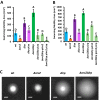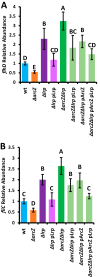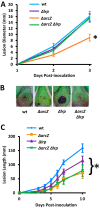The Leucine-Responsive Regulatory Protein Lrp Participates in Virulence Regulation Downstream of Small RNA ArcZ in Erwinia amylovora
- PMID: 31138749
- PMCID: PMC6538786
- DOI: 10.1128/mBio.00757-19
The Leucine-Responsive Regulatory Protein Lrp Participates in Virulence Regulation Downstream of Small RNA ArcZ in Erwinia amylovora
Abstract
Erwinia amylovora causes the devastating fire blight disease of apple and pear trees. During systemic infection of host trees, pathogen cells must rapidly respond to changes in their environment as they move through different host tissues that present distinct challenges and sources of nutrition. Growing evidence indicates that small RNAs (sRNAs) play an important role in disease progression as posttranscriptional regulators. The sRNA ArcZ positively regulates the motility phenotype and transcription of flagellar genes in E. amylovora Ea1189 yet is a direct repressor of translation of the flagellar master regulator, FlhD. We utilized transposon mutagenesis to conduct a forward genetic screen and identified suppressor mutations that increase motility in the Ea1189ΔarcZ mutant background. This enabled us to determine that the mechanism of transcriptional activation of the flhDC mRNA by ArcZ is mediated by the leucine-responsive regulatory protein, Lrp. We show that Lrp contributes to expression of virulence and several virulence-associated traits, including production of the exopolysaccharide amylovoran, levansucrase activity, and biofilm formation. We further show that Lrp is regulated posttranscriptionally by ArcZ through destabilization of lrp mRNA. Thus, ArcZ regulation of FlhDC directly and indirectly through Lrp forms an incoherent feed-forward loop that regulates levansucrase activity and motility as outputs. This work identifies Lrp as a novel participant in virulence regulation in E. amylovora and places it in the context of a virulence-associated regulatory network.IMPORTANCE Fire blight disease continues to plague the commercial production of apples and pears despite more than a century of research into disease epidemiology and disease control. The causative agent of fire blight, Erwinia amylovora coordinates turning on or off specific virulence-associated traits at the appropriate time during disease development. The development of novel control strategies requires an in-depth understanding of E. amylovora regulatory mechanisms, including regulatory control of virulence-associated traits. This study investigates how the small RNA ArcZ regulates motility at the transcriptional level and identifies the transcription factor Lrp as a novel participant in the regulation of several virulence-associated traits. We report that ArcZ and Lrp together affect key virulence-associated traits through integration of transcriptional and posttranscriptional mechanisms. Further understanding of the topology of virulence regulatory networks can uncover weak points that can subsequently be exploited to control E. amylovora.
Keywords: FlhDC; Hfq; fire blight.
Copyright © 2019 Schachterle and Sundin.
Figures










References
-
- Van der Zwet T, Orolaza-Halbrendt N, Zeller W. 2012. Fire blight: history, biology, and management. American Phytopathological Society, St. Paul, MN.
-
- Bayot RG, Ries SM. 1986. Role of motility in apple blossom infection by Erwinia amylovora and studies of fire blight control with attractant and repellent compounds. Phytopathology 76:441–445. doi:10.1094/Phyto-76-441. - DOI
-
- Ivanoff S, Keitt G. 1941. Relations of nectar concentration to growth of Erwinia amylovora and fire blight infection of apple and pear blossoms. J Agric Res 62:733–743.
-
- Holtappels M, Vrancken K, Schoofs H, Deckers T, Remans T, Noben J-P, Valcke R. 2015. A comparative proteome analysis reveals flagellin, chemotaxis regulated proteins and amylovoran to be involved in virulence differences between Erwinia amylovora strains. J Proteomics 123:54–69. doi:10.1016/j.jprot.2015.03.036. - DOI - PubMed
Publication types
MeSH terms
Substances
LinkOut - more resources
Full Text Sources
Miscellaneous

